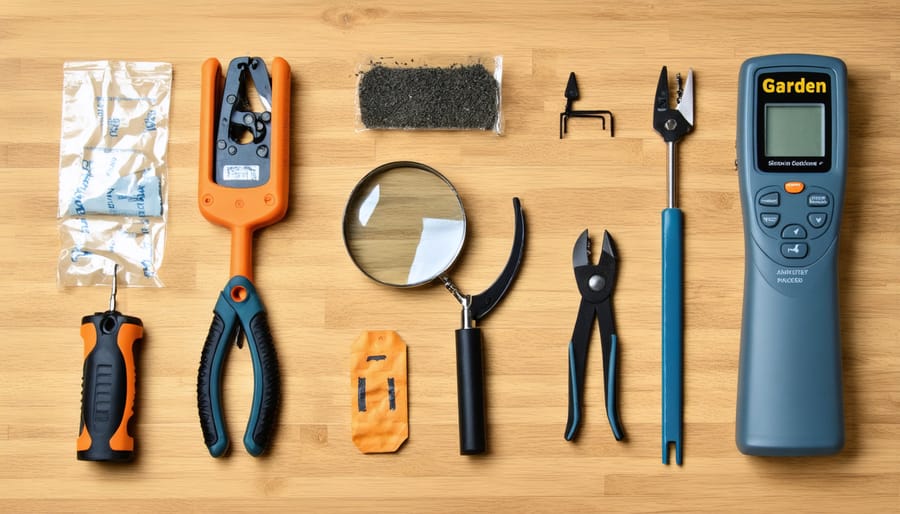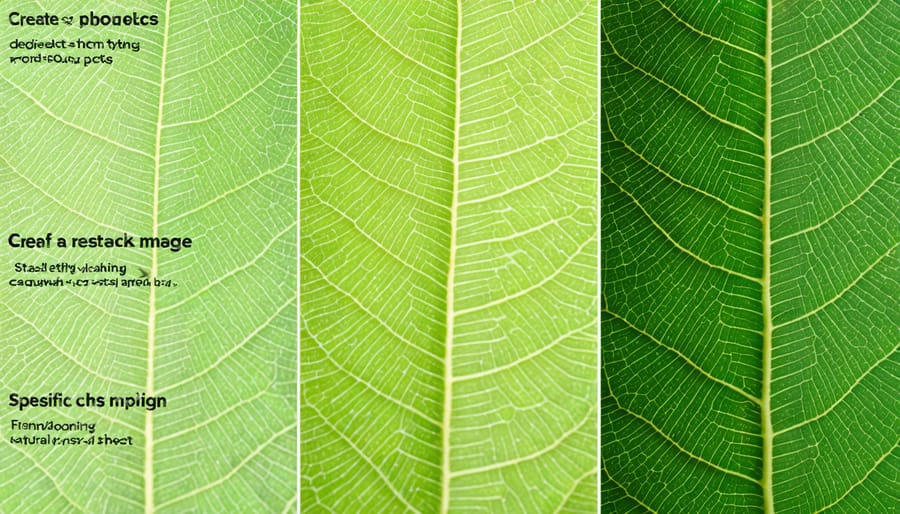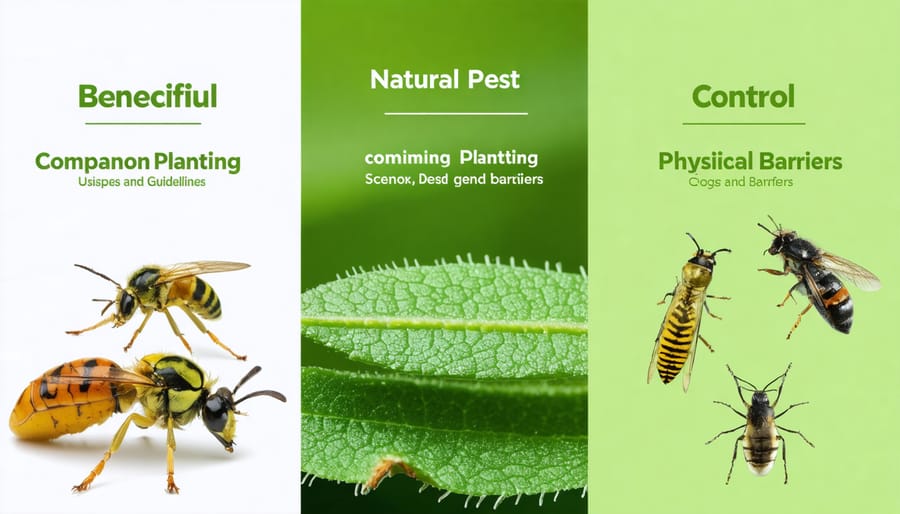Monitor your garden daily with yellow sticky traps and visual inspections, catching pest problems before they escalate into full-blown infestations. Establish an integrated pest management system combining biological controls like beneficial insects, physical barriers such as row covers, and targeted organic sprays to create multiple layers of protection. Map pest activity patterns in your garden using a simple notebook or digital app, recording where problems occur and which solutions prove most effective. Document seasonal pest cycles, weather conditions, and treatment outcomes to build a personalized pest management strategy that grows stronger with each growing season.
Natural predators, strategic plant placement, and healthy soil form the foundation of sustainable pest control – implementing these core practices reduces the need for intervention while fostering a resilient garden ecosystem. Whether dealing with aphids in your vegetable patch or Japanese beetles in your flower beds, success comes from understanding pest life cycles and taking swift, informed action using the right combination of monitoring tools and control methods.
Setting Up Your Garden Monitoring System
Essential Monitoring Tools
Monitoring tools are your first line of defense in spotting and managing garden pests effectively. Sticky traps come in various colors – yellow ones attract whiteflies and aphids, while blue ones are perfect for thrips. Place these traps strategically around your garden, checking them weekly to track pest populations and identify potential problems early.
Pheromone traps are another invaluable tool, specifically designed to attract and monitor specific pest species. These clever devices use natural insect hormones to lure males, helping you determine when pest populations are reaching concerning levels.
A good quality magnifying glass is essential for any gardener’s toolkit. It helps you examine leaves closely for tiny pests and their eggs, enabling early detection before an infestation takes hold. Look for a magnifier with 10x magnification for best results.
Digital pest monitoring devices are becoming increasingly popular among modern gardeners. These smart tools can track environmental conditions that attract pests and even send alerts to your phone when conditions are favorable for pest activity. Some advanced models include cameras and automated identification features, making pest monitoring more accessible than ever.
Remember to keep detailed records of your monitoring results – this information becomes invaluable for preventing future pest problems and understanding seasonal patterns in your garden.

Creating Your Monitoring Schedule
Regular monitoring is the cornerstone of effective pest management, and creating a consistent schedule will help you catch problems early. Start by designating specific days each week for garden inspections – many successful gardeners choose early morning hours when pests are most active and visible.
Keep a garden journal or digital log to track your observations. Note any signs of pest activity, including chewed leaves, discoloration, or actual pest sightings. Include weather conditions and seasonal changes, as these factors often influence pest behavior. Taking photos can help you document changes over time and share concerns with other gardeners or experts when needed.
Divide your garden into manageable sections and rotate through them systematically. Pay special attention to vulnerable plants and areas where you’ve had pest issues before. Consider using sticky traps or pheromone monitors in strategic locations to help track pest populations.
Create a simple checklist that includes:
– Examining both sides of leaves
– Checking stem joints and new growth
– Inspecting soil surface and mulch
– Looking for beneficial insects
– Recording plant health and growth
Remember, consistency is key. Even a quick 15-minute daily walk-through can help you maintain a pest-free garden. Adjust your schedule seasonally, increasing monitoring frequency during peak pest periods.
Key Signs of Pest Activity
Leaf Damage Patterns
Learning to read leaf damage patterns is like being a garden detective – each pest leaves behind its own unique signature. Caterpillars typically create irregular holes or completely stripped leaves, often leaving behind the leaf veins. If you notice these patterns along with small dark droppings beneath the plants, you’ve likely identified your culprit.
Slugs and snails create irregular holes with smooth edges, usually starting from the leaf edges and working their way inward. These pests are especially active at night and in damp conditions, leaving behind telltale silvery slime trails as evidence of their presence.
Leaf miners create distinctive serpentine tunnels or blotchy patterns between the upper and lower leaf surfaces. These translucent trails are actually where the pest larvae feed, protected inside the leaf tissue. Japanese beetles, on the other hand, feed between leaf veins, creating a characteristic skeletal or lace-like appearance.
Watch for stippling – tiny light dots on leaves – which typically indicates spider mites or other sap-sucking insects. Aphids cause leaves to curl and become distorted, often accompanied by sticky honeydew residue. Grasshoppers leave behind ragged, torn edges and tend to feed from the outside of the leaf moving inward.
By familiarizing yourself with these distinct feeding patterns, you can quickly identify which pests are visiting your garden and take appropriate action before the problem escalates.

Hidden Pest Indicators
Even when pests aren’t immediately visible, they often leave behind telltale signs of their presence. Learning to spot these subtle indicators can help you catch problems early before they become major infestations. Look for fine, silky webbing in plant corners and between leaves – this is often a sign of spider mites or other web-spinning insects. Small dark droppings, known as frass, around plant bases or on leaves can indicate caterpillar or beetle activity.
Pay attention to unexplained soil disturbance, like small holes or tunnels, which might suggest the presence of root-feeding pests or burrowing insects. Mysterious sawdust-like material around woody plants could mean wood-boring insects have made themselves at home. Watch for irregular leaf patterns too – trails of transparent tissue where the green has been eaten away often indicate leaf miners at work.
Other subtle signs include sticky residue on leaves (a sign of aphids or scale insects), yellow or white speckling on leaf surfaces (evidence of spider mites or thrips), and unexplained wilting despite proper watering. Even things like ants marching in organized lines up plant stems can indicate they’re farming aphids for honeydew.
By becoming familiar with these hidden indicators, you can take action before pest problems escalate, protecting your garden’s health and vitality.
Taking Action: Response Strategies
Prevention Techniques
The best approach to pest management is taking action before problems escalate. Start by maintaining healthy soil through regular composting and proper drainage, as robust plants naturally resist pests better. Create physical barriers like row covers or netting around vulnerable plants, especially during peak pest seasons.
Companion planting is another effective strategy – try planting aromatic herbs like basil, marigolds, or lavender near your vegetables. These natural pest deterrents not only add beauty to your garden but also confuse and repel unwanted visitors.
Establish good garden hygiene practices by removing dead leaves, fallen fruit, and debris regularly. These materials can harbor pests and diseases, providing them perfect breeding grounds. Prune overcrowded areas to improve air circulation, which helps prevent fungal issues and makes your garden less appealing to pests.
Water your plants early in the day and at soil level rather than overhead. This practice keeps foliage dry and reduces conditions that attract pests and promote disease. Consider installing drip irrigation systems for more efficient watering.
Create habitat for beneficial insects by incorporating diverse flowering plants throughout your garden. Ladybugs, praying mantises, and parasitic wasps are natural predators that help keep pest populations in check.
Regular inspection of your plants is crucial – take a few minutes each week to look for early warning signs like holes in leaves, discoloration, or unusual growth patterns. The sooner you spot potential issues, the easier they are to address with minimal intervention.
Remember to rotate your crops annually to prevent pest populations from becoming established in specific areas. This simple yet effective practice can significantly reduce recurring pest problems.
Natural Control Methods
When it comes to managing garden pests effectively, natural control options offer safe and sustainable solutions that work in harmony with your garden’s ecosystem. One of the most effective approaches is companion planting, where you strategically place pest-repelling plants like marigolds, nasturtiums, or lavender alongside your vulnerable crops.
Creating a diverse garden environment naturally attracts beneficial insects like ladybugs, praying mantises, and parasitic wasps, which help keep pest populations in check. You can encourage these helpful allies by providing water sources, shelter, and flowering plants that offer nectar and pollen.
Physical barriers offer another excellent natural defense. Row covers, netting, and copper tape can prevent insects and slugs from reaching your plants. For smaller gardens, handpicking pests during morning or evening hours can be surprisingly effective, especially for larger insects like tomato hornworms or Japanese beetles.
Biological controls, such as introducing beneficial nematodes to combat soil-dwelling pests or using Bacillus thuringiensis (Bt) for caterpillar control, provide targeted solutions without harmful chemicals. These methods are particularly effective when you’ve properly identified the specific pest causing damage.
Remember to maintain healthy soil through regular composting and proper irrigation, as strong plants naturally resist pest problems better than stressed ones. Creating habitat diversity with different plant heights, types, and flowering times helps maintain a balanced garden ecosystem where pests are less likely to gain the upper hand.
For persistent problems, consider making your own natural pest deterrent sprays using ingredients like neem oil, garlic, or mild soap solutions. These homemade remedies can be effective while being gentle on your garden’s beneficial inhabitants and the environment.

When to Use Chemical Controls
While sustainable gardening emphasizes natural pest control methods, there are situations when chemical interventions become necessary. The key is knowing exactly when to use these stronger measures, and more importantly, when not to.
First, always establish your threshold for damage. A few nibbled leaves might look unsightly but won’t harm your garden’s overall health. However, if you notice pest populations rapidly increasing or damage affecting more than 30% of your plants, it’s time to consider chemical controls.
Before reaching for pesticides, ask yourself these essential questions:
– Have you tried all available natural control methods?
– Is the pest problem severe enough to justify chemical use?
– Are beneficial insects present that could be harmed?
– Is the timing right for treatment to be effective?
Chemical controls are most appropriate when:
– Quick action is needed to save valuable crops
– Natural predators aren’t controlling the pest population
– Disease-carrying pests pose health risks
– Previous organic methods have proven ineffective
– Weather conditions favor rapid pest multiplication
Remember to start with the least toxic options first, such as insecticidal soaps or horticultural oils. These milder treatments often provide effective control while minimizing impact on beneficial insects and the environment.
Always read product labels carefully and apply treatments during the pest’s most vulnerable life stage. Early morning or evening applications typically work best, when beneficial insects are less active and temperatures are cooler.
Most importantly, use chemical controls as part of an integrated pest management strategy, not as your first line of defense. By combining careful monitoring, prevention, and various control methods, you’ll create a more resilient garden that requires fewer chemical interventions over time.
Successful pest management in your garden isn’t a one-time effort but rather an ongoing journey that requires dedication and consistent monitoring. By implementing the techniques we’ve discussed, you’re not just protecting your plants – you’re creating a more resilient and healthier garden ecosystem that will reward you with abundant harvests and beautiful blooms.
Remember that early detection is your best defense against pest problems. Make monitoring part of your regular gardening routine, perhaps during your morning coffee or evening garden stroll. Take note of any changes in your plants’ appearance, check your sticky traps weekly, and maintain detailed records of what you observe. This information becomes invaluable over time, helping you identify patterns and respond more effectively to potential threats.
Don’t be discouraged if you encounter setbacks – even experienced gardeners face pest challenges. The key is to remain proactive and adapt your approach as needed. Start with one or two monitoring techniques that feel manageable, and gradually expand your pest management strategy as you become more comfortable.
By taking these steps to protect your garden, you’re not just practicing good gardening – you’re becoming a more knowledgeable and confident gardener. Your efforts in pest management today will contribute to a thriving, sustainable garden that you can enjoy for years to come. So grab your notebook, set up those monitoring stations, and embrace your role as guardian of your garden’s health.




